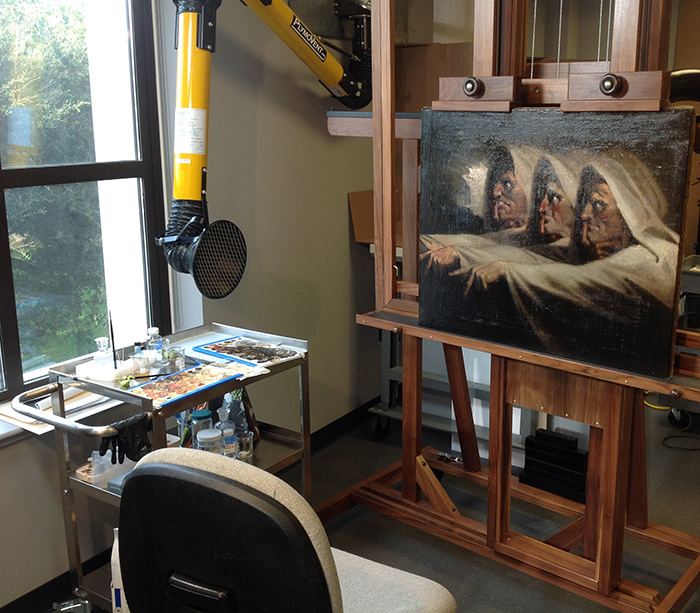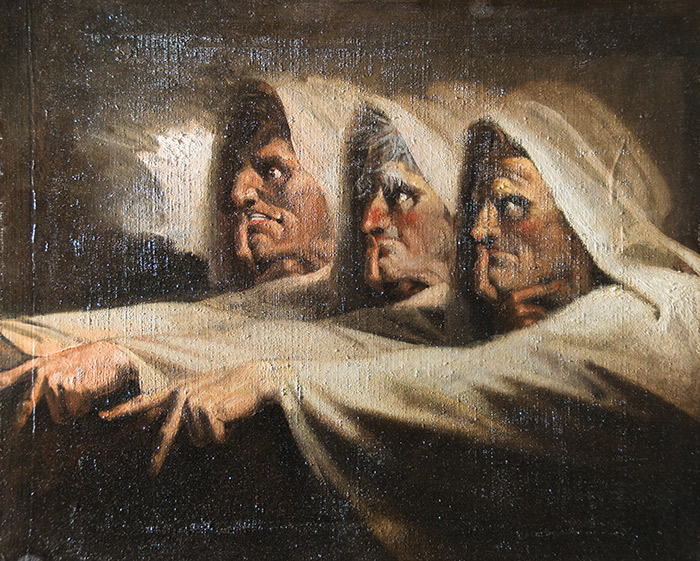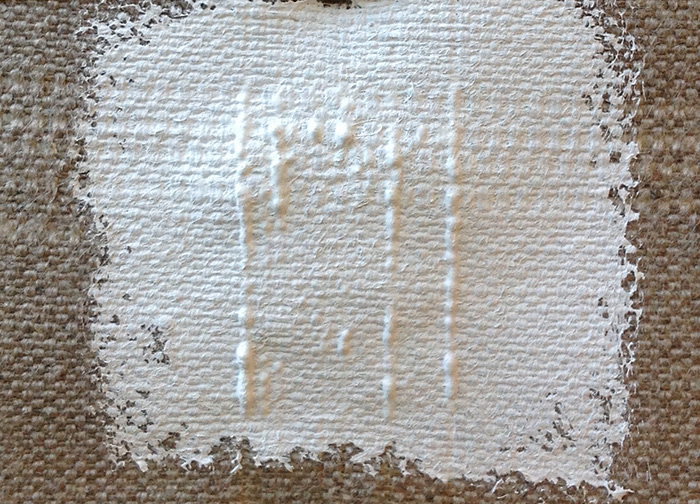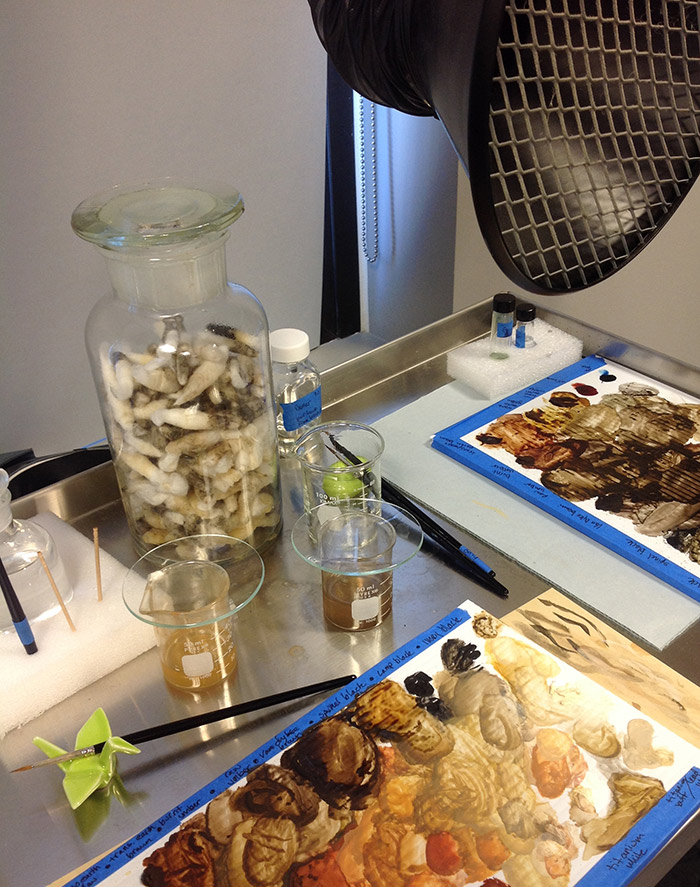The Huntington’s blog takes you behind the scenes for a scholarly view of the collections.
More Than Meets the Eye
Posted on Tue., Dec. 16, 2014 by

New painting acquisitions needing care now make a stop in The Huntington's conservation lab before being put on view. In the case of The Three Witches, there was more than met the eye.
In 2012, The Huntington received a $500,000 grant from the Mellon Foundation to develop an integrated preservation program that would serve both the Library and Art divisions. Previously, only books and works of art on paper received treatment in the preservation department’s conservation laboratory, with paintings being cared for by outside conservators. The Huntington has now hired a paintings conservator and is in the process of developing a dedicated conservation lab. In this post, paintings conservator Christina O’Connell describes her work on a recent acquisition, Anglo-Swiss painter Henry Fuseli’s The Three Witches (1782).
Fuseli's The Three Witches came to the painting conservation lab for treatment shortly after its arrival at The Huntington. I needed to stabilize some flaking paint and clean the painting before it went on view in the Huntington Art Gallery. Almost immediately, I could see there was a story hiding under the surface, including changing formats and multiple layers.
The surface of The Three Witches was rough, with a pebbly texture. Previous assessments had attributed that to the heavy, coarse canvas. But I had another theory. Could The Three Witches be double-sided? Paint from the back of the painting could have seeped through the weave, explaining the nubby surface. If so, it wouldn’t be the only example where Fuseli painted on both sides of his canvas. Fuseli’s most famous work, The Nightmare, at the Detroit Institute of Arts, is double-sided. I’ve been in ongoing communication with conservation colleagues at the DIA to discuss the technical similarities between our Fuseli and theirs.

By shining bright light across its surface, the painting more clearly shows the pebbly texture and a vertical seam where a new strip of canvas was added along the left side.
One technique I used to emphasize the texture and detail of The Three Witches was raking light, which involved sweeping a bright light across the painting’s surface. The bright, oblique light made it easier to document in photos the painting’s pebbly texture, as well as another curiosity—a vertical seam on the left side (more on that later).
I illustrated my theory about a double-sided painting by recreating the effect with a scrap of new canvas. I took a small piece of canvas with the same weave structure as The Three Witches and applied white acrylic paint on the back with a stiff brush. The white paint made it really easy to see and photograph the texture (see the related image). The small mock-up even had the same vertical and horizontal ‘pebble’ pattern as The Three Witches due to the warp and weft of the canvas.
I have no doubt there’s something on the other side of The Three Witches, but here’s the challenge: the painting was lined with a fabric support during a previous restoration and we can’t see what’s underneath. In order to get a better idea, we’ll have to x-ray it. That would give us a view of all the layers, including the ones now hidden from view. Once the painting comes off display, we’ll discuss plans to carry out x-ray analysis.

To illustrate her theory of a double-sided painting, the conservator applied white paint to the back of this canvas sample. The resulting texture gives credence to her theory.
My examination also revealed other details that add to the technical complexity of The Three Witches. The seam along the left side of the canvas had old tack holes on the seam’s right side. The only explanation is that the canvas was once attached to a smaller stretcher and then was extended for the current composition. To me, this was additional evidence that the canvas was reused. To what extent remains a question. And is there something complete on the other side?
After my examination was finished, I began the conservation treatment, which includes stabilizing some small areas of flaking paint, removing layers of dirt and discolored varnish, and “inpainting,” which is filling in areas where paint is missing due to damage and abrasion. Removing the dark varnish dramatically improved the look of the painting. The varnish had obscured subtle details, rendering the composition flat and less three-dimensional. During the cleaning process, even more surprises emerged. In the upper left corner, I found something hidden under several layers of darkened varnish and at least two campaigns of old overpaint (painting from a previous restoration covering up some original paint): a small, moon-like shape. The red “moon” is badly damaged, but I could see the edges of the entire shape, giving me an understanding of what it may have looked like. We have lots of questions about this mysterious moon, including whether it was intended as part of The Three Witches, or if it was part of an earlier canvas that was re-used.

Using a mixture of organic solvents and cotton swabs, the conservator removed thick layers of discolored varnish.
I plan to conduct one additional test—cross-sectional analysis. This involves taking tiny samples of all the layers of the painting, embedding it in a polymer or resin, and sanding it from the side to understand the structure and order of all the paint layers. As with the x-ray analysis, we’ll have to wait until after the exhibition to do this.
The Three Witches currently hangs in the second floor of the Huntington Art Gallery. Now that this initial phase of conservation treatment is complete, you can better enjoy the dramatic lighting of Fuseli’s composition and the bold, energetic strokes of paint. Come and see if you can find all the details mentioned in this post!
Related content on Verso:
“Which Witch?” (Oct. 10, 2014)
“A Magic Brew?” (Oct. 31, 2014)
Christina O'Connell is senior paintings conservator in the preservation department at The Huntington.